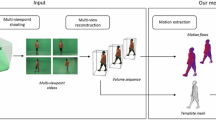Abstract
In this paper, a novel method for three-dimensional (3D) segmentation and motion estimation based on 3D videos provided by TOF cameras is presented. The problem is formulated by a variational statement derived from the maximum a posterior probability (MAP) using 3D Optical Flow Constraint, containing both evolution surface and motion parameters. Therefore, the proposed method allows them to benefit from each other and perform motion segmentation and estimation simultaneously. All the formulation is under the assumption that environmental objects are rigid, and an iterative, PDE-driven level set method is adopted for energy minimization. Various experimental results show the validity of the proposed algorithm.










Similar content being viewed by others
References
Bouthemy, P., & François, E. (1993). Motion segmentation and qualitative dynamic scene analysis from an image sequence. International Journal of Computer Vision, 10(2), 157–182.
Potter, J. L. (1975). Velocity as a cue to segmentation. IEEE Transactions on Systems, Man and Cybernetics 390–394.
Dufaux, F., Moccagatta, I., Moscheni, F., & Nicolas, H. (1994). Vector quantization-based motion field segmentation under the entropy criterion. Journal of Visual Communication and Image Representation, 5, 356–369.
Paragios, N., & Deriche, R. (2005). Geodesic active regions and level set methods for motion estimation and tracking. Computer Vision and Image Understanding, 97(3), 259–282.
Schnörr, C. (1991). Determining optical flow for irregular domains by minimizing quadratic functionals of a certain class. International Journal of Computer Vision, 6(1), 25–38.
Mémin, E., & Pérez, P. (2002). Hierarchical estimation and segmentation of dense motion fields. International Journal of Computer Vision, 46(2), 129–155.
Yi, X., & Yu, H. Contour-based motion segmentation using few priors. ICSP2006, pp 1376-1379.
Feghali, R., & Mitiche, A. (2004). Spatiotemporal motion boundary detection and motion boundary velocity estimation for tracking moving objects with a moving camera: a level sets PDEs approach with concurrent camera motion compensation. IEEE Transactions on Image Processing, 13(11), 1473–1490.
Alvarez, L., Castaño, C. A., Garcfa, M., Krissian, K., Mazorra, L., Salgado, A., & Sánchez, J. (2009). A new energy-based method for 3d motion estimation of incompressible PIV flows. Computer Vision and Image Understanding, 113(7), 802–810.
Furukawa, Y., & Ponce, J. (2010). Dense 3D motion capture from synchronized video streams. Image and geometry processing for 3-D cinematography. Geometry and Computing, 5(2), 193–211.
Arun, K., Huang, T., & Blostein, S. (1987). Least-squares fitting of two 3D point sets. IEEE Transactions on Pattern Analysis and Machine Intelligence, 9, 698–700.
Matei, B., & Meer, P. (1999). Optimal rigid motion estimation and performance evaluation with bootstrap. In Proc. IEEE Conf. on Computer Vision and Pattern Recognition, Fort Collins, CO, volume 1, pp. 339–345.
Heeger, D. J., & Jepson, A. D. (1992). Subspace methods for recovering rigid MotionI: algorithm and implementation. International Journal of Computer Vision, 7, 95–117.
Adiv, G. (1989). Inherent ambiguities in recovering 3D motion and structure from a noisy flow field. IEEE Transactions on Pattern Analysis and Machine Intelligence, 11, 477–489.
Droeschel, D., et al. (2009). Robust ego-motion estimation with tof cameras. Proceeding of 4th European Conference on Mobile Robots, pp. 187–192, September.
Villaverde, I., & Grana, M. (2009). An improved evolutionary approach for egomotion estimation with a 3D TOF camera. Proceedings of the 3rd International Work-Conference on The Interplay Between Natural and Artificial Computation: Part II: Bioinspired Applications in Artificial and Natural Computation, pp. 390–398.
Ohno, K., Nomura, T., & Tadokoro, S. (2006). Real-Time Robot Trajectory Estimation and 3D Map Construction using 3D Camera. In IEEE/RSJ International Conference on Intelligent Robots and Systems (IROS), Beijing, China, October.
Miticha, A., Feghali, R., & Mansouri, A. (2003). Motion tracking as spatio-temporal motion bounfary detection. Journal of Robotics and Autonomous Systems, 43(1), 39–50.
Longuet-Higgins, H., & Prazdny, K. (1980). The interpretation of a moving retinal image. Proceedings of the Royal Society of London, Series B 385–397.
Adiv, G. (1985). Determining three-dimensional motion and structure from optical flow general by several moving objects. IEEE Transactions on Pattern Analysis and Machine Intelligence, PAMI-7, No.4, July.
Waxman, A. M. (1984). An image flow paradigm. In Proceedings of the Second IEEE Workshop on Computer Vision: Representation and Control, Annapolis, pp. 49–57.
Waxman, A. M., & Ullman, S. (1985). Surface structure and 3-D motion from image flow: a kinematic analysis. International Journal of Robotics Research.
Horn, B., & Schunck, B. (1981). Determining optical flow (pp. 185–203). MIT Artificial Intelligence Laboratory.
Chan, T. F., & Vese, L. A. (2001). Active contours without edges. IEEE Transactions on Image Processing, 10, 266–277.
Caselles, V. (1995). Geometric models for Active Contours. In Proceeding of the 1995 International Conference on Image Processing, Vol. 3, pp. 3009.
Leventon, M. E., et al. (2000). Statistical Shape Influence in Geodesic Active Contours. In 2000 IEEE Computer Society Conference on Computer Vision and Pattern Recognition (CVPR’00), Vol. 1, pp. 1316.
Brox, T., et al. (2003). Unsupervised segmentation incorporating colour, texture, and motion. Lecture Notes in Computer Science, 2756, 353–360.
Mansouri, A. R., & Konrad, I. (2003). Multiple motion segmentation with level sets. IEEE Transactions on Image Processing, 12(2), 201–220.
Mitiche, A., Sekkati, H. (2006). Optical flow 3D Segmentation and interpretation: a variational method with active curve evolution and level sets. IEEE Transactions on Pattern Analysis and Machine Intelligence, 28(11), November.
Osher, S., & Sethian, J. A. (1988). Fronts propagating with curvature dependent speed: algorithms based on Hamilton-Jacobi formulations. Journal of Computational Physics, 79, 12–49.
Whitaker, T. R. (1998). A level set approach to 3D reconstruction from range data. The International Journal of Computer Vision, 29(3), 203–231.
Author information
Authors and Affiliations
Corresponding author
Additional information
This work was supported by NSFC under Grant No.60872069 and a National Key Basic Research Project of China (973 Program No.2012CB316400).
Rights and permissions
About this article
Cite this article
Wang, S., Yu, H. & Hu, R. 3D Video Based Segmentation and Motion Estimation with Active Surface Evolution. J Sign Process Syst 71, 21–34 (2013). https://doi.org/10.1007/s11265-012-0675-5
Received:
Revised:
Accepted:
Published:
Issue Date:
DOI: https://doi.org/10.1007/s11265-012-0675-5




